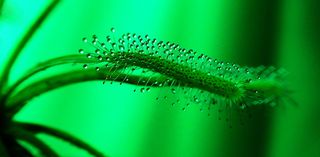The Nanotechnology of Sundew and English Ivy

This Behind the Scenes article was provided to LiveScience in partnership with the National Science Foundation.
Fifteen small sundew plants perch on a windowsill collecting sunlight and eating meat in the lab of Mingjun Zhang on the University of Tennessee's Knoxville campus. Sundew plants are carnivores, consuming insects by capturing them with small adhesive balls on the ends of their tentacles.
The tentacles and their adhesive properties may be nature's design for catching insects, but Zhang's research team hopes that one day this same adhesive can help attach your grandmother's replacement hip or your artificial knee without fear that your bodies will reject it.
Post-doctoral researcher Scott Lenaghan explained that the idea behind this research at the Nano Bio-systems and Bio-mimetics Lab is to learn from biological principles and apply engineering along the way to develop an end product that uses these compounds and principles to advance technology.
Finding organic biomaterials
The lab's goal is to study biological material on the nanoscale — a million times smaller than a grain of sand — in hopes of mimicking what nature has done for millions of years and applying it to daily life, just like soaring birds inspired the creation of airplanes.
In medical replacement operations, "you need something cells can recognize and attach to," Lenaghan said. With the sundew, the researchers may have found just that, as the nanoparticles in its adhesive are easily recognized by human cells.
Sign up for the Live Science daily newsletter now
Get the world’s most fascinating discoveries delivered straight to your inbox.
In addition to research on the astounding adhesive properties of the carnivorous sundew plant, Zhang and his colleagues are exploring nanoparticles found in English ivy. These particles can scatter light, and may possibly be an alternative to the metal-based nanoparticles presently used in sunscreen, said Lenaghan. The researchers reported their work, supported by grants from the National Science Foundation and the Army Research Office, in a 2010 paper in the Journal of Nanobiotechnology.
Medical uses
In August 2010, Zhang's group published the article "Nanofibers and nanoparticles from the insect-capturing adhesive of the sundew (Drosera) for cell attachment" in the Journal of Nanobiotechnology. They reported that naturally occurring nanofibers and nanoparticles from the secreted adhesive of the sundew show a high compatibility for attaching cells.
Lenaghan also notes that the nanofibers could potentially be used on adhesive bandages to improve wound healing by coating cuts with biological materials that excite cell activity, instead of just covering a wound with cotton.
The sundew's adhesive has Spiderman qualities. For example, it can stretch to one million times its normal size. Most rubber bands can stretch to only about six times their original length. This remarkable elasticity makes the adhesive dew secreted from the plant a potentially effective choice for coating replacement body parts, regenerating dying tissues, healing wounds and improving synthetic adhesives. It is so sticky and elastic that it's also economical — less than a microliter (0.0002 teaspoons) would cover 25 square millimeters (about 0.04 square inches).
Zhang's lab collaborates with the Plant Biotechnology Department at the University of Tennessee to grow sundews in their greenhouse and the team uses imaging resources from Michigan State University to observe and record their findings.
Other uses
While medical applications for nanoparticles continue to develop, one of the leading uses of nanoparticles today is in cosmetics. The nanoparticles ensure the multiple ingredients interact appropriately to make smoothing and glowing effects.
"We have been contacted by several cosmetic companies inquiring about our research and its applications," said Lenaghan.
Sundew and English ivy research in Zhang's lab are a part of a growing field of "next generation" materials that have a broad interdisciplinary impact. The hope is to replace the many synthetic products we use daily with naturally occurring substances.
"In the ideal scenario if you had a broken bone, you want a substance that will biodegrade as your tissues heal around it, making what is left your material," Lenaghan said.
Don't be surprised if one day soon you can buy band-aids made from sundew.
Editor's Note: This research was supported by the National Science Foundation, the federal agency charged with funding basic research and education across all fields of science and engineering. Any opinions, findings, and conclusions or recommendations expressed in this material are those of the author and do not necessarily reflect the views of the National Science Foundation. See the Behind the Scenes Archive.
Most Popular





